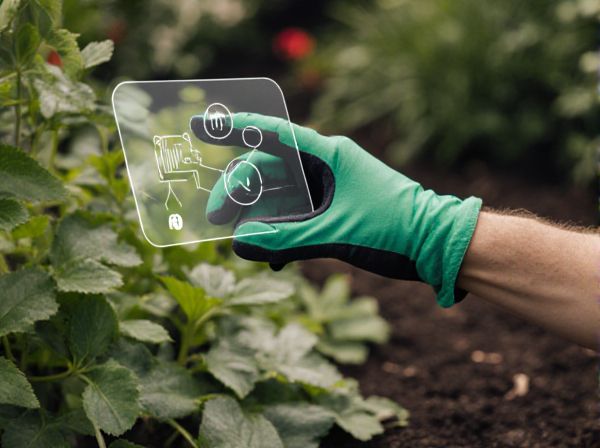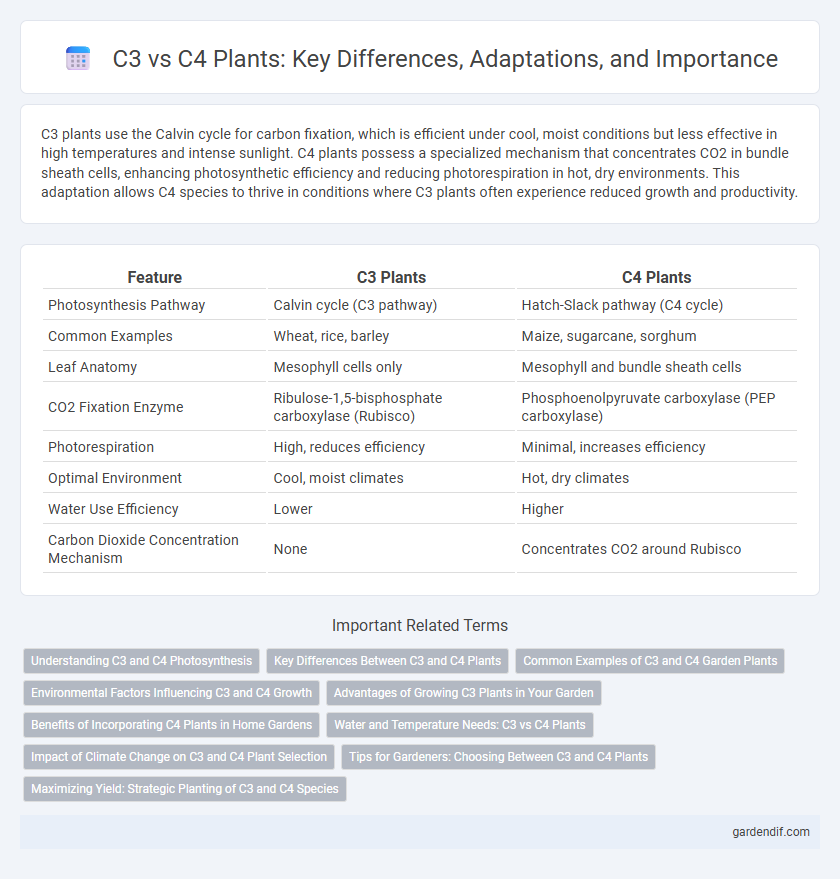
C3 vs C4 Illustration
C3 plants use the Calvin cycle for carbon fixation, which is efficient under cool, moist conditions but less effective in high temperatures and intense sunlight. C4 plants possess a specialized mechanism that concentrates CO2 in bundle sheath cells, enhancing photosynthetic efficiency and reducing photorespiration in hot, dry environments. This adaptation allows C4 species to thrive in conditions where C3 plants often experience reduced growth and productivity.
Table of Comparison
| Feature | C3 Plants | C4 Plants |
|---|---|---|
| Photosynthesis Pathway | Calvin cycle (C3 pathway) | Hatch-Slack pathway (C4 cycle) |
| Common Examples | Wheat, rice, barley | Maize, sugarcane, sorghum |
| Leaf Anatomy | Mesophyll cells only | Mesophyll and bundle sheath cells |
| CO2 Fixation Enzyme | Ribulose-1,5-bisphosphate carboxylase (Rubisco) | Phosphoenolpyruvate carboxylase (PEP carboxylase) |
| Photorespiration | High, reduces efficiency | Minimal, increases efficiency |
| Optimal Environment | Cool, moist climates | Hot, dry climates |
| Water Use Efficiency | Lower | Higher |
| Carbon Dioxide Concentration Mechanism | None | Concentrates CO2 around Rubisco |
Understanding C3 and C4 Photosynthesis
C3 photosynthesis, found in most plants like wheat and rice, involves fixing carbon dioxide directly through the Calvin cycle, which operates efficiently under moderate light and temperature but is prone to photorespiration. C4 photosynthesis, characteristic of plants such as maize and sugarcane, incorporates an additional step where CO2 is initially fixed into a four-carbon compound, significantly reducing photorespiration and enhancing water and nitrogen use efficiency in high light and temperature environments. Understanding the biochemical and anatomical differences between C3 and C4 pathways is crucial for improving crop productivity and adapting plants to climate change challenges.
Key Differences Between C3 and C4 Plants
C3 plants fix carbon through the Calvin cycle, producing a three-carbon compound, whereas C4 plants initially fix carbon into a four-carbon compound using the Hatch-Slack pathway. C4 plants exhibit higher photosynthetic efficiency and better adaptation to hot, dry environments due to their ability to minimize photorespiration. C3 plants are more common in cooler, wetter climates, while C4 species are predominant in tropical and subtropical regions with intense sunlight.
Common Examples of C3 and C4 Garden Plants
Tomato, spinach, and rice are common C3 garden plants that thrive in cooler, shaded environments with moderate sunlight. Corn, sugarcane, and amaranth are typical C4 garden plants adapted to hot, sunny climates with high photosynthetic efficiency and water use. Understanding the difference between C3 and C4 plant types helps optimize garden planning and crop selection for specific environmental conditions.
Environmental Factors Influencing C3 and C4 Growth
C3 plants thrive in cooler, wetter environments with moderate light intensity, benefiting from their efficient photosynthesis under high carbon dioxide levels and cooler temperatures. C4 plants dominate in hot, arid conditions due to their specialized leaf anatomy and enzyme systems that minimize photorespiration, enabling higher water-use efficiency and tolerance to drought and high light intensities. Soil moisture, temperature, and atmospheric carbon dioxide concentrations significantly influence the distribution and growth rates of C3 and C4 species, shaping ecosystem productivity and agricultural practices.
Advantages of Growing C3 Plants in Your Garden
Growing C3 plants in your garden offers several advantages, including their adaptability to cooler, temperate climates and efficient growth under moderate light conditions. These plants typically require less water and nutrients compared to C4 species, making them suitable for sustainable gardening practices. Furthermore, C3 plants contribute significantly to local biodiversity by supporting a wide range of pollinators and soil microorganisms.
Benefits of Incorporating C4 Plants in Home Gardens
Incorporating C4 plants in home gardens enhances water-use efficiency by minimizing photorespiration, making them ideal for dry or hot climates. C4 plants like maize and sugarcane exhibit faster growth rates and higher productivity under intense sunlight compared to C3 species. Their ability to thrive in nutrient-poor soils reduces the need for fertilizers, promoting sustainable gardening practices.
Water and Temperature Needs: C3 vs C4 Plants
C3 plants typically require more water due to higher rates of photorespiration, thriving in cooler, shaded environments with moderate temperatures around 15-25degC. C4 plants exhibit greater water-use efficiency, adapting to hot, arid conditions by concentrating CO2 and reducing water loss, enabling optimal photosynthesis at temperatures above 30degC. The physiological differences in stomatal behavior between C3 and C4 plants directly influence their water and temperature needs, making C4 species more drought-resistant and suited for tropical and subtropical climates.
Impact of Climate Change on C3 and C4 Plant Selection
Climate change influences C3 and C4 plant selection through varying responses to temperature, CO2 levels, and water availability. Elevated CO2 generally benefits C3 plants by enhancing photosynthesis efficiency, while C4 plants maintain higher water-use efficiency and perform better under high temperatures and drought conditions. Shifts in regional climates may favor the expansion of C4 species in warmer, drier areas, whereas increased CO2 may improve C3 crop yields in cooler, wetter environments.
Tips for Gardeners: Choosing Between C3 and C4 Plants
Gardeners should select C3 plants such as lettuce, spinach, and tomatoes for cooler, shaded areas because they thrive in moderate temperatures and lower light conditions. C4 plants like maize, sugarcane, and sorghum excel in hot, sunny environments and water-limited soils due to their efficient photosynthesis and reduced photorespiration. Balancing soil type, sunlight exposure, and local climate helps optimize growth by matching plant photosynthetic pathways to environmental conditions.
Maximizing Yield: Strategic Planting of C3 and C4 Species
Maximizing agricultural yield requires strategic planting of C3 and C4 species based on their photosynthetic pathways and environmental adaptations. C3 plants, such as wheat and rice, thrive in cooler, moist environments with moderate sunlight, while C4 plants like maize and sugarcane excel in hot, dry climates with intense sunlight due to their higher water-use efficiency and carbon fixation rates. Integrating both plant types in crop rotation or intercropping systems optimizes land use, enhances photosynthetic efficiency, and ultimately boosts overall productivity.
C3 vs C4 Infographic

 gardendif.com
gardendif.com